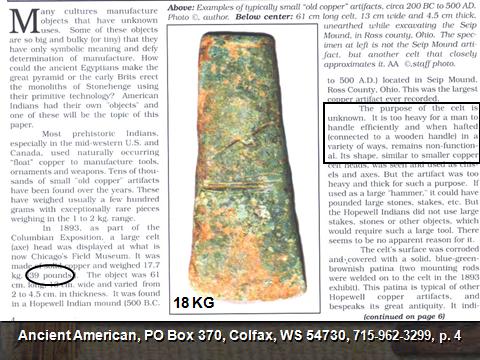39 lb Hand-Axe found in Ohio
39 lb Hand-Axe
Many cultures manufacture objects that have unknown uses. Some of these objects are so big and bulky (or tiny) that they have only symbolic meaning and defy determination, of manufacture. How could the ancient Egyptians make the great pyramid or the early Brits erect the monnolths at Stonehenge using their primitive technology? American Indians had their own “objects” and one of these will be the topic of this papre.
Most prehistoric Indians especially in the mid-western U.S. and Canada used naturally occurring “finest” copper to manufacture tools, ornaments and weapons. Tens of thousands of “old copper” artifacts have been found over the years. These have weighed usually a few hundred grams with exceptionally rare pieces wighing in the 1 to 2 kg range.
In 1893 as part of the Columbian Exposition a large celt axe head was displayed in what is now Chicago’s Field Museum. It was made with copper and weighed 17.7 kg. 39 pounds. The object was 61 cm length ????? wide and varied from 2 to 4.5 cm in thickness. It was found in a Hopewell Indians mound 1500 B. C..
Examples of typically small “old copper” artifacts, circs 200 BC to 500 AD.
61 cm long celt, 13 cm wide and 4.5 cm thick. unearthed while excavating the Serp mound. in Ross county, Ohio. The specemin at left is not the Serp mound artifact, last another celt that closely approximates it.
In 500 A. D. located in Serp mound, Ross county, Ohio. This is the largest copper artifact ever recorded.
The purpose of the celt is unknown. It is too heavy for a man to handle efficiently and when hafted connected to a wooden basket in a variety of ways, remains nonfunctional, Its shape similar to smaller copper celt heaths were seen and used as ???????? and axes, But the artifact was too heavy and thick for such a purpose. If used as a large “hammer” it could have pounded large stones, stakes, etc. But the Hopewell Indians did not use large stakes. stories of other objects, which would require such a large tool, there seems to be an apparrent reason for it.
The celt’s surface was corroded and covered with a solid, blue-green brownish patina. [Two mounting rods were added on to the celt in 1893 exhibit. ] This patina is typical of other Hopewell copper artifacts, and bespeaks its great antiquity.
Another culprit, there is plenty of blame to go around. Almost but not every missing artifact is solely blamed on the Smithsonian, here the Chicago Field Museum is said to be in possession of this artifact. I the Chicago Field Museum’s name was in every coverup, they would be the attention of Giantologist Researchers. Although there are too many to mention that implicate the Smithsonian, its nice to see they are not the only Museum hoarding/stealing giant artifacts.
Note: I have been to the Field Museum in Chicago and took lot’s of pictures. My main focus of the museum was the giant Lions, a revertion back to their greater ancestry. It was my personal favorite item, from the show “The Ghost and the Darkness” I suggest you visit the museum if you are in Chicago, also visit the Greater Ancestors World Museum wher you can see a replica of the copper axe to exact scale, . . . which is more than what you will you will see at the Field Museum.
~Chris L Lesley/GAWMuseum
Giant Axes and tools: Evidence of REAL Giants.


Comment